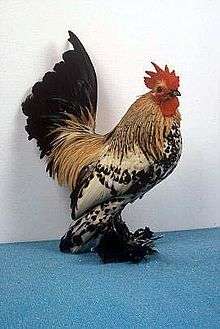Booted Bantam
The Booted Bantam or Dutch Booted Bantam, Dutch: Sabelpoot, is a bantam breed of chicken. Its name is derived from the extravagant feathering on the feet and hock joints, which are called vulture hocks or "sabels" in Dutch. With no large fowl counterpart from which it was miniaturized, the Booted is one of the true bantams. Males usually weigh in at around 850 grams (30 ounces) and females 750 grams (27 ounces). American standards dictate a smaller ideal size of 740 grams (26 ounces) for males, and 625 (22 ounces) for females.
 A Lemon Millefleur rooster | |
| Other names | |
|---|---|
| Country of origin | Netherlands |
| Traits | |
| Weight |
|
| Classification | |
| APA | feather legged[1] |
| PCGB | rare true bantam[2] |
| |
Characteristics
Booted Bantams are angular birds with profuse plumage. They have broad backs, breasts carried well forward, and relatively large, downward-pointing wings following the line of the vulture hocks. They do not quite reach the floor though. Booted Bantams have a single upright comb with five points, horn-colored beaks, red wattles, and red earlobes. Almost exclusively an exhibition chicken raised by poultry fanciers, they appear in more than a twenty colour varieties. Colours accepted in shows include: Barred, Black, Blue, Buff, Cuckoo, Columbian, Gray, Golden Neck, Millefleur (the most common), Mottled, Partridge, Lavender, Lemon Millefleur, Porcelain, Self Blue, Silver Millefleur and White.
Long kept as pets in addition to being shown, Booted Bantams are usually friendly and calm. They are good foragers, and are said to do less damage to garden plants because of their heavily feathered feet. However, most breeders keep their Booted Bantams confined and on soft bedding in order to maintain these feathers.[3] Hens readily go broody, and lay very small eggs that are white or tinted in color. Their egg production is respectable for bantams, especially in summer.
History
The Booted Bantam is closely related to the Belgian Barbu d'Uccle. The most significant differences in conformation between the two are the d'Uccle's feather beard and the greater height of the Booted.[4] Some sources assert the two breeds share a singular point of origin, with a Belgian breeder around the beginning of the 20th century.[5] Other sources point to a clearly documented presence in the Netherlands since the 16th century,[6] and note that the Booted Bantam is known to this day in the Netherlands, as the Nederlandse Sabelpootkriel (Dutch, Dutch saber-legged bantam).[4] Whatever their exact relation, Booted Bantams and Bearded d'Uccles are only two of a handful of chicken breeds to possess vulture hocks, (Sultans do too).
Popular across Europe for hundreds of years, the Booted Bantam was imported to North America from Germany in the late 19th century. It was officially recognized by the American Poultry Association in 1879. It is also recognized by the American Bantam Association, and is classed in the Feather Legged group.]
Booted Bantam UK
Booted Bantams in the UK are catered for by the Booted Bantam Society UK. The breed has 11 colours accepted by the Poultry Club of Great Britain. These are black, black mottled, blue, buff mottled, cuckoo, lavender, lemon millefleur, millefleur, porcelain, silver millefleur, white. The black and white Booted Bantams were created in the UK and have been here for over 100 years. In recent years more colours have been imported into the UK from mainland Europe and the most popular colour by far is the Lemon Millefleur Booted Bantam. Although not shown in large numbers at present they are a very popular pet and are becoming more common in people's back gardens. They are a breed that can be susceptible to a form of Mareks Disease although this can be bred out within a few years.
Footnotes
- APA Recognized Breeds and Varieties: As of January 1, 2012. American Poultry Association. Archived 4 November 2017.
- Breed Classification. Poultry Club of Great Britain. Archived 12 June 2018.
- Staples pp. 40, 56, 80
- "belgianduccle.org". Brief History: Belgian d'Uccle and Booted Bantam. The American Belgian d'Uccle & Booted Bantam Club. Archived from the original on 2013-07-29.
- Ekarius p. 111
- Graham p. 135
References
- Ekarius, Carol (2007). Storey's Illustrated Guide to Poultry Breeds. 210 MAS MoCA Way, North Adams MA 01247: Storey Publishing. ISBN 978-1-58017-667-5.CS1 maint: location (link)
- Graham, Chris (2006). Choosing and Keeping Chickens. 2-4 Heron Quays London E14 4JP: Octopus Publishing. ISBN 978-0-7938-0601-0.CS1 maint: location (link)
- Heinrichs, Christine (2007). How To Raise Chickens. Voyageur Press. ISBN 978-0-7603-2828-6.
- Staples, Tamara (2001). The Fairest Fowl. Chronicle Books. ISBN 0-8118-3137-X.